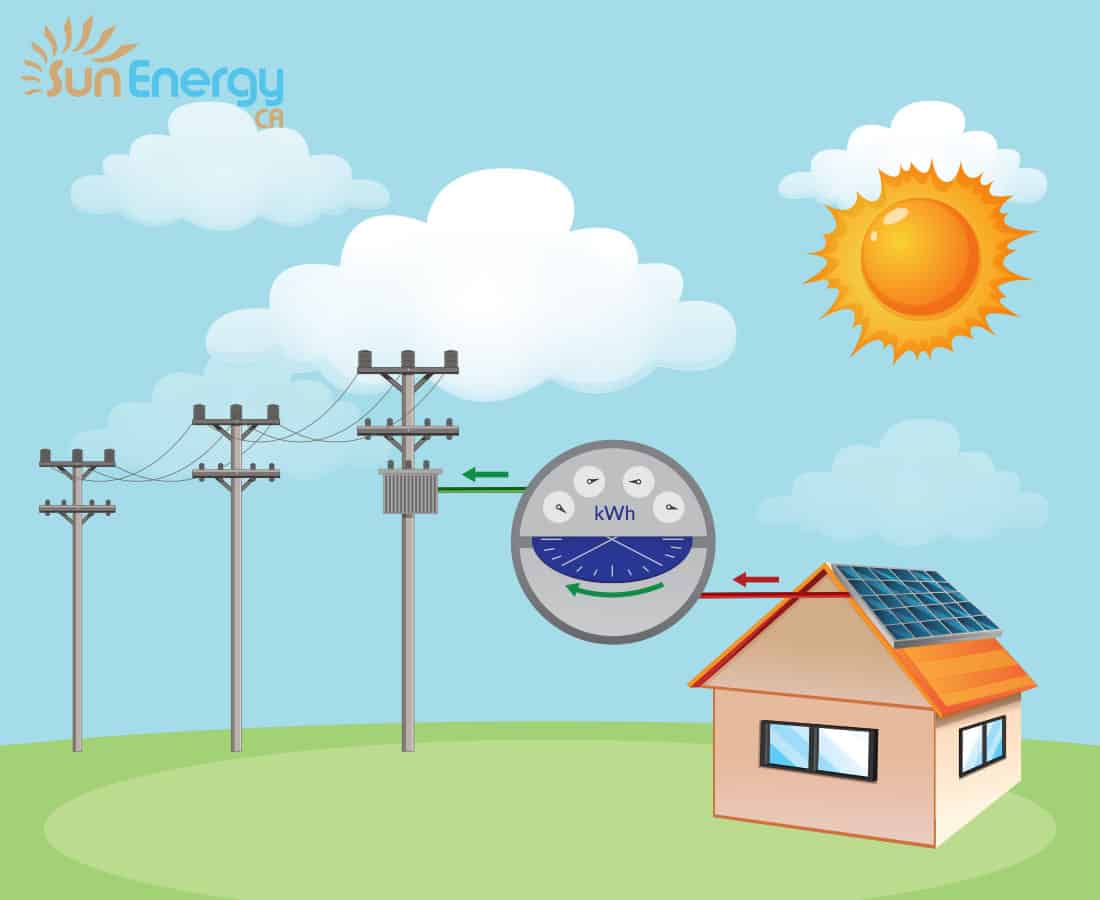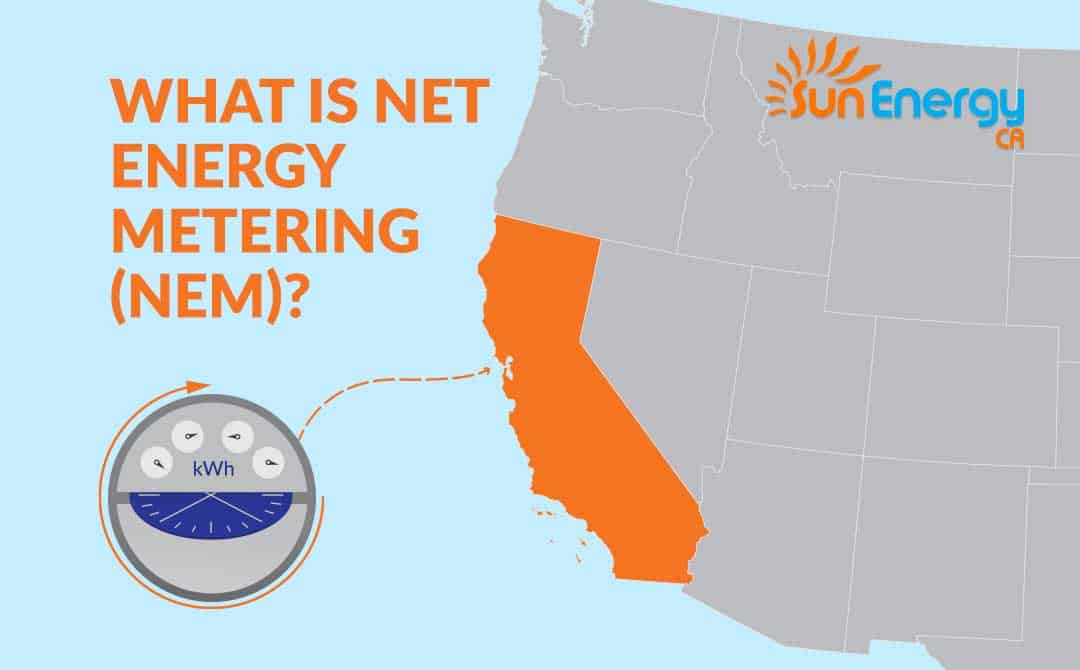How Does Net Energy Metering Work in California?
Net energy metering for the state of California is one of the many benefits that make us the undisputed champion for solar energy. Here in the Golden State, we saw over 26,000 megawatts of solar panels installed in the third quarter of 2019 alone, five times the amount of North Carolina, the #2 state. #Winning
Prefer Video? Well You’re in Luck!
Below we have a 4 minute in-depth video that tells you everything you need to know about net energy metering.
What Exactly is Net Energy Metering?
In simple terms, the energy you produce, minus the energy you consume, equals net energy.
Net energy metering (or NEM) is a solar incentive that allows you to store energy in the electric grid. When you have solar panels, it’s not uncommon to produce more electricity than you use. That extra energy is sent to the utility grid in exchange for credits. If your home is using more electricity than it can produce, you will pull energy from the grid and use the credits to pay for it. This is especially helpful at night when your solar panels cannot generate electricity. Pretty sweet, huh?
Using a reputable solar installation company, like Bright Solar Power California, to install your panels is vital because they will do an excellent job ensuring your home has the right size solar system. With the right size solar system, you can produce enough electricity to match your home’s needs for the entire year. The weather changes throughout the year, so it’s normal that the amount of electricity your solar panels generate will vary. Net metering allows you to store energy credits so you can use it when you need it most. With this benefit, electric utility customers that have solar panels typically save tens of thousands of dollars on electricity costs over the lifetime of the solar panels.
How does NEM work?
The original program was pretty simple: for every kWh you provide, you get one kWh to use. While your solar panels were feeding energy into the grid, you would get the exact amount of energy back in credits to use when you need it. With the right size of the system, you would never need to pay for energy from your utility.
The new net energy metering makes some small changes to our original policy. The one thing that does not change, are the energy bill credits. Homeowners and businesses that enroll in the new NEM will still receive per-kWh credits for their extra energy. These credits will still have the same value of one kWh on utility electricity.
In addition to preserving the retail rate of bill credits, the new California net metering program also prohibits many fixed charges for residential customers. Charges that have been removed include demand charges, grid access charges, installed capacity fees, and even standby fees.
The three main differences between the original California net metering policy and the new NEM are time-of-use rates, non-bypassable charges, and interconnection fees. The California Solar Energy Industries Association (or CalSEIA) has estimated that these additional charges combined will have an impact of about $10 more on your monthly bill.
Time-of-Use Rates (TOU)
Supply and demand of electrical energy on the grid will affect the rate you pay for electricity. During times of high demand, electricity will be the most expensive. These times are usually around 4:00 PM to 9:00 PM, when everyone is home from work and ready to relax. Utility companies will charge more per kWh during these ‘peak hours’. However, for solar customers, this is the best time to feed extra energy back into the grid. Your extra energy is worth more during peak hours, and you’ll get more credits from energy fed into the system.
NEM ensures that every homeowner that has a solar panel system is automatically using TOU rates on their bills. The price of your electricity per kWh will depend on your utility company. Solar energy systems with the right design can perform just as economically under the new NEM as they would have been in the original policy. Typically TOU rates are at their lowest during nights and weekends in the winter, and at the highest during the afternoon and evening in summer. Homes with solar panels on NEM can maximize the net metering credits by placing some panels on the west side of the house. This way the panels can also capture the afternoon sunlight.
Interconnection Fee
After the installation of your solar panels, they will need to be set up to send electricity back to the grid. Before that can happen, a representative from the city will need to inspect the system and sign-off on the installation. This process also has a one-time fee associated with the connection to the grid. It is called an ‘interconnection fee. This fee ranges from $130 to $150, depending on your utility provider.
Non-Bypassable Charges
Non-bypassable charges (also known as NBC’s) are additional fees added to each kWh built into utility electricity prices. Generally, these fees add up to around 3¢ per kWh. The funds go to good causes, like funding low-income customer assistance, energy efficiency programs, and other related services.
These charges were not part of the original net energy metering program. Customers operating under that policy do not have to pay NBCs on energy that they bought from month-to-month. Under NEM, new homeowners will have to pay NBCs, but only for the kWh of electricity they buy and not what they generate. No energy generated from your home’s solar panels will be subject to these charges.
Your Utility Company
Every utility company in our area is currently accepting enrollment for NEM. This became mandatory on July 1, 2017. Utility customers that enrolled in the original net metering policy will have 20 years to take advantage of that program. After that, they will be changed to the new NEM.
California’s Public Utilities Commission had already planned to update this policy very soon. 2020 has been a crazy year, and many deliberations have been postponed. The evaluation for NEM was completed on June 30, 2020. This means that the new NEM may be extended or replaced with a new policy soon. A new policy may see a reduction in benefits such as net metering.

NEM in 2020
Getting a solar panel system now will lock you into NEM for 20 years. The ‘grandfather’ clause protects homeowners from any reduction in benefits that may be announced in a new policy. The benefit of net metering under the new NEM combined with federal income tax credits and other incentives makes California still the best place for solar power. Californians stand to make big monthly savings over the life-span of their solar panels.
Waiting to get solar panels may make you ineligible for benefits like these. If you are interested in getting solar panels for your home, you should move quickly. We can help you with more information about what size of system you need and how much it may cost!
Contact us today and learn more about solar panels for your home! Our solar advisors offer no-pressure, free consultations!
Questions About Going Solar?
If you have questions about going solar, please don’t hesitate to reach out to us here at Bright Solar Power California. We take pride in our ability to provide our customers with the information they need to make the best decisions for their family. We also offer free consultations and estimates. Call 760.545.8466. We look forward to working with you!

